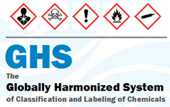Global Harmonization Standard – HAZCOM for the World
 New changes to the Occupational Safety and Health Administration’s (OSHA) Hazard Communication (HAZCOM) Standard are intended to bring the United States (US) into alignment with the Globally Harmonized System (GHS) of Classification and Labeling of Chemicals. OSHA says that “The HAZCOM Standard in 1983 gave workers the right to know, but the new GHS Standard gives workers the right to understand.” The new standard accomplishes this through changes to hazard classification, labels, safety data sheets and training.
New changes to the Occupational Safety and Health Administration’s (OSHA) Hazard Communication (HAZCOM) Standard are intended to bring the United States (US) into alignment with the Globally Harmonized System (GHS) of Classification and Labeling of Chemicals. OSHA says that “The HAZCOM Standard in 1983 gave workers the right to know, but the new GHS Standard gives workers the right to understand.” The new standard accomplishes this through changes to hazard classification, labels, safety data sheets and training.
What do you need to know?
• Hazard classification changes will require re-classification of product hazards. Specific physical and health hazard classifications have been identified. The hazard categories are opposite from previously used NFPA / HMIS ranges. The new standard ranges from 1 for severe to 5 for minimal hazard in contrast to 0 for minimal to 4 for severe hazard under the previous categories.
• Labels will need to be re-designed to contain specific elements including product identifier (from SDS), signal word (Danger or Warning), hazard statement (as assigned to the hazard class and category), pictograms (specific symbols), precautionary statements and chemical manufacturer contact information. Secondary labels will not need to be modified as long as they contain the product identifier and a description of the primary hazard.
• Safety Data Sheets (SDS) will need to be revised to the new fixed format with standardized section headings. Exposure and emergency response information will be placed at the beginning of the document. New libraries of safety data sheets will need to be compiled.
• Information and training will need to be updated for all chemical users and employees regarding the new hazard classifications, labels and safety data sheets.
What do you need to do? When?
• Employers must train employees on the new label elements and new safety data sheet format by December 1, 2013.
• Chemical manufacturers, importers and distributors, as well as employers, must comply with the new Hazard Communication Standard requirements by June 1, 2015 except that chemical distributors may ship containers without the GHS labels.
• Chemical distributors must ship products labeled under the new standard meeting the GHS requirements after December 1, 2015.
• Employers must update any alternative workplace labeling and hazard communication programs as necessary and provide additional employee training for newly identified physical or health hazards.
• During the transition period prior to the compliance dates identified, chemical manufacturers, importers distributors, and employers may comply with either standard or both.
If you have questions regarding the new hazard communication standard requirements and implementation, please call Don Hart, Project Manager at 717-517-5000 x230.